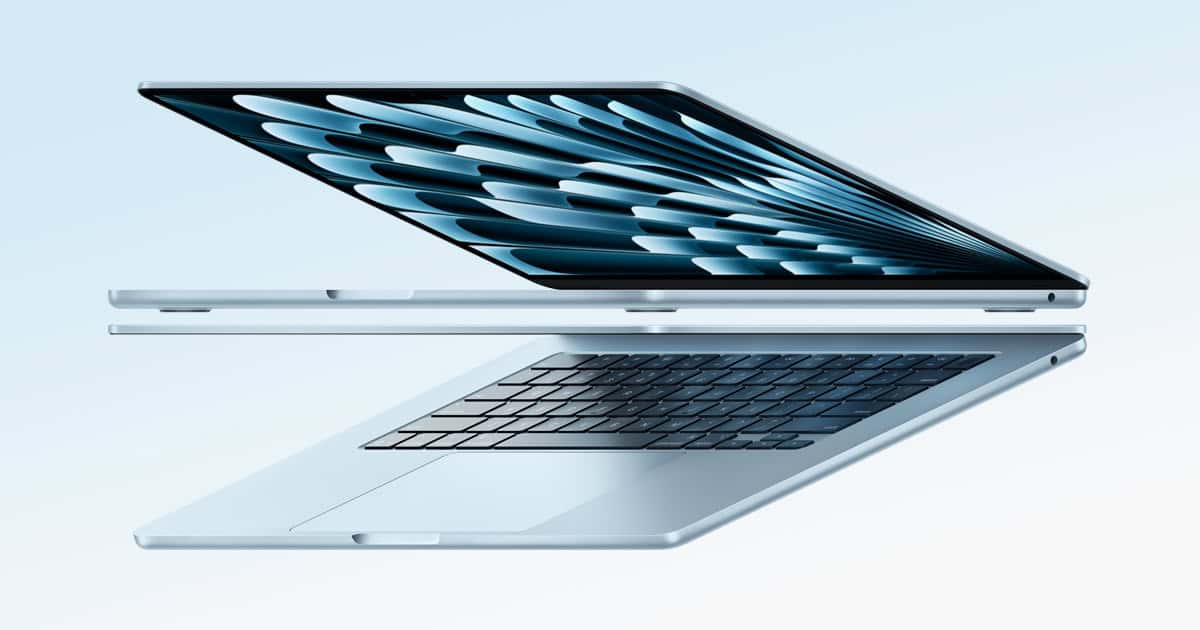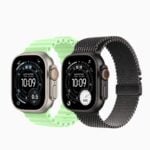Choosing between a MacBook Air and MacBook Pro can feel overwhelming with all the specs and price differences. Both laptops offer Apple’s sleek design and powerful performance, but they serve different needs and budgets. The MacBook Air is better for everyday users who want a lightweight, portable device with great battery life, while the MacBook Pro is ideal for professionals who need extra power for video editing, programming, or other demanding tasks.
The differences go beyond just weight and power. The MacBook Air is thinner, doesn’t have a cooling fan, and costs less than the Pro models. The Pro offers a better screen, more ports (including HDMI and SD card slots on some models), and can support more external displays at once. While the Air wins on portability, the Pro takes the crown for battery life in most tests.
MacBook Air (M4) vs MacBook Pro (M4 Pro / M4 Max)
Choosing between the MacBook Air and MacBook Pro in 2025 isn’t as straightforward as it once was. Apple’s latest M-series chips have blurred the lines between lightweight and performance machines, and both the Air and Pro lineups have seen major upgrades this year.
Whether you’re a student, creative professional, coder, or general user, this breakdown will help you decide which MacBook fits your workflow and budget best.
| Feature | MacBook Air (M4) | MacBook Pro (M4 Pro / M4 Max) |
|---|---|---|
| Sizes | 13-inch, 15-inch | 14-inch, 16-inch |
| Chip Options | M4 (10-core CPU, 8–10-core GPU) | M4 Pro / M4 Max (up to 16-core CPU, 40-core GPU) |
| RAM | 16GB (up to 32GB) | 18GB / 36GB (up to 128GB) |
| Storage | 256GB–2TB | 512GB–8TB |
| Display | Liquid Retina (IPS LCD) | Liquid Retina XDR (Mini-LED) with ProMotion (120Hz) |
| Battery Life | Up to 18 hours | Up to 22 hours (16-inch model) |
| Ports | 2x Thunderbolt / USB 4, MagSafe | 3x Thunderbolt 4, HDMI, SDXC, MagSafe |
| Weight | ~2.7 lbs (13″) to 3.3 lbs (15″) | ~3.5 lbs (14″) to 4.7 lbs (16″) |
| Starting Price | $999 | $1,999 (M4 Pro) |
Why Choose the MacBook Air in 2025?

The MacBook Air with M4 is the sweet spot for most users in 2025. It’s faster than many entry-level Windows laptops, quieter thanks to its fanless design, and lighter to carry around. It now starts with 16GB of unified memory by default — something that used to be reserved for higher-end models.
Best For:
- Students
- Business users
- Writers, web designers, casual coders
- Light photo/video editing (especially with the 10-core GPU variant)
Key Advantages:
- Excellent performance for everyday tasks and light creative work
- Improved support for dual external displays
- Great battery life in a slim profile
- Lower cost and lighter than the Pro
- Now supports 12MP Center Stage camera for better video calls
Why the MacBook Pro Still Reigns for Power Users

If you’re doing professional video editing, working with large codebases, running virtual machines, or pushing AI models, the MacBook Pro (M4 Pro or Max) is where things really open up. The M4 Max in particular is unmatched for on-the-go power.
Best For:
- Software developers
- Video editors, 3D artists, musicians
- Designers using heavy Adobe or CAD tools
- Data scientists or researchers with local AI workloads
Key Advantages:
- 120Hz ProMotion Mini-LED display is far superior for color grading, HDR, and smooth motion
- More RAM, more GPU cores, and better thermal performance under load
- Additional ports: no need to live off dongles
- Support for up to four external displays (M4 Max)
Buying Tips Based on Use Case
| User Type | Recommended Model |
|---|---|
| College Student | 13″ MacBook Air (M4) – Portability + price |
| Remote Professional | 15″ MacBook Air (M4) – Larger screen, better multitasking |
| App Developer / Xcode | 14″ MacBook Pro (M4 Pro) – More memory & power |
| Video Editor / Creative Pro | 16″ MacBook Pro (M4 Max) – Display & GPU horsepower |
| Everyday Home Use | 13″ MacBook Air (M4) – Best value overall |
| AI Developer or Researcher | 16″ MacBook Pro (M4 Max, 64GB RAM+) |
Real-World Performance Benchmarks
Apple’s M4 chip brings notable improvements over the M3, especially in sustained workloads. However, the M4 Pro and M4 Max absolutely dominate in multicore and GPU-heavy tasks.
| Test / App | M4 MacBook Air | M4 Pro MacBook Pro | M4 Max MacBook Pro |
|---|---|---|---|
| Geekbench 6 – Single Core | ~3,200 | ~3,150 | ~3,150 |
| Geekbench 6 – Multi Core | ~13,800 | ~19,500 | ~21,800 |
| Cinebench R23 (Multicore) | ~9,200 | ~14,000 | ~16,200 |
| PugetBench for Premiere Pro | 660 | 890 | 1,280 |
| Xcode Project Build Time (Large App) | ~68 sec | ~43 sec | ~36 sec |
| Blender Render (BMW Test) | ~4m 20s | ~2m 45s | ~1m 50s |
| Final Cut Pro – 4K Export | ~3m 10s | ~1m 50s | ~1m 15s |
🟡 Note: The M4 Pro and M4 Max sustain performance far better under continuous load, thanks to active cooling and more power headroom.
Thermal Performance & Fan Noise
The MacBook Air (M4) is completely fanless, meaning it’s silent at all times—but that also limits how long it can sustain peak performance. After a few minutes of heavy CPU or GPU usage, it will begin to throttle down slightly to manage heat.
| Test Type | MacBook Air (M4) | MacBook Pro (M4 Pro/Max) |
|---|---|---|
| Fan Noise | 0 dB (silent) | 20–38 dB under load |
| Surface Temp (Peak) | ~44°C | ~42°C |
| Throttling Risk | Moderate in long tasks | Minimal |
| Sustained Workload | Tapers after 5–7 min | Maintains peak for 20+ min |
For quick bursts of productivity like compiling or exporting a short video, the Air holds its own. But for continuous rendering, code compiling, or gaming, the Pro maintains high performance longer and stays cooler thanks to active cooling.
Battery Life Comparison
Battery life is impressive across all 2025 models, but Apple still reserves its best battery optimization for the MacBook Air, thanks to its fanless, lower-power design.
| Usage Scenario | M4 Air (13″) | M4 Pro (14″) | M4 Max (16″) |
|---|---|---|---|
| Web Browsing | ~17.5 hours | ~13.5 hours | ~12.5 hours |
| Video Playback | ~18 hours | ~17 hours | ~22 hours (bigger battery) |
| Zoom / FaceTime Calls | ~10.5 hours | ~9 hours | ~8.5 hours |
| Code Compilation | ~9 hours | ~11.5 hours | ~11 hours |
| Light Photo Editing | ~12 hours | ~10 hours | ~9.5 hours |
🟢 Best battery overall: The 16-inch M4 Max MacBook Pro actually lasts longest for media playback due to its larger battery (100Wh), while the 13-inch M4 Air wins for light day-to-day tasks.
Key Takeaways
- MacBook Air offers the best value for everyday users who want portability and good performance.
- MacBook Pro provides extra power, better display quality, and more ports for professional work.
- Both laptops run the same software and offer similar security features, making your choice mainly about hardware needs and budget.
Product Line Overview
Apple’s laptop lineup offers distinct choices for different user needs. The MacBook Air focuses on portability while the MacBook Pro delivers maximum performance, though both share Apple’s core design philosophy and technology.
Evolution of the MacBook Air
The MacBook Air has transformed from Apple’s ultra-thin laptop experiment to a mainstream powerhouse. The latest models feature the M3 chip that delivers impressive performance without needing a cooling fan.
Today’s MacBook Air comes in two sizes: the classic 13.6-inch and the newer 15-inch model. Both maintain the Air’s signature tapered design while weighing significantly less than Pro models.
The Air’s most defining characteristic is its fanless design, making it completely silent even under heavy workloads. This lightweight champion targets students, writers, and everyday users who prioritize portability over maximum processing power.
Recent Air models include improved displays, better battery life, and MagSafe charging, addressing previous limitations while maintaining the line’s focus on mobility.
Advancements in MacBook Pro
The MacBook Pro has evolved from simply being a “more powerful laptop” to a specialized tool for creative professionals. Current offerings include 14-inch and 16-inch models with mini-LED displays that deliver stunning visual quality.
Pro models exclusively offer Apple’s most powerful silicon options: the M4 Pro and M4 Max chips. These advanced processors enable complex tasks like 8K video editing and 3D rendering that would overwhelm Air models.
The Pro line features important extras that serious professionals need:
- HDMI ports and SD card slots
- Higher resolution displays (254 pixels per inch vs. 224 on Air models)
- Active cooling systems for sustained performance
- More GPU cores for graphics-intensive work
MacBook Pro models also include better speakers, more Thunderbolt ports, and longer battery life, justifying their higher price point for power users.
MacBooks Commonalities
Despite their differences, both MacBook lines share Apple’s core design language and technology foundation. All current models feature aluminum unibody construction, excellent build quality, and similar keyboard designs.
Every modern MacBook runs on Apple silicon, leaving Intel processors behind. This transition has dramatically improved performance while extending battery life across the entire lineup.
Both Air and Pro models run the same macOS operating system, giving users access to the same software and Apple Intelligence features. This means even Air users enjoy the same core experience as Pro users.
The trackpad experience remains consistent across all models, with Force Touch technology providing excellent precision. Apple’s integration of hardware and software creates a seamless experience regardless of which model you choose.
Security features like Touch ID and the T2 security chip appear in both lines, ensuring data protection regardless of price point.
Design and Build
Apple’s MacBook Air and MacBook Pro showcase distinct design philosophies while maintaining the iconic Apple aesthetics. Their physical differences directly impact portability, usability, and who they might best serve.
Materials and Aesthetics
Both MacBook models feature aluminum unibody designs that provide excellent durability and premium feel. The MacBook Air has a design similar to the Pro, but with a more tapered shape. While the Pro maintains a professional silver and space gray color palette, the Air offers more variety with options like starlight, midnight, silver, and space gray.
The Pro has a more industrial appearance with its flat sides and slightly more robust build. This design choice supports its cooling system and additional ports.
The MacBook Pro includes a black keyboard well that contrasts with its aluminum body, while the Air’s keyboard area matches its overall color theme for a more unified look.
Dimensions and Weight
The physical differences between these laptops are significant for daily use:
| Feature | MacBook Air | MacBook Pro (14″) |
|---|---|---|
| Weight | 2.7 pounds | 3.5 pounds |
| Thickness | 0.44 inches | 0.61 inches |
The MacBook Air is lighter than the MacBook Pro partly because it lacks certain hardware components like the cooling fan that the Pro includes. This makes the Air more suitable for frequent travelers and commuters.
The Pro’s larger size accommodates additional ports including HDMI and an SD card slot, which the Air lacks. This trade-off between portability and connectivity is a key consideration for buyers.
Ergonomics and Usability
Both laptops offer excellent typing experiences with backlit Magic Keyboards featuring 1mm of key travel. Touch ID is integrated into the power button on both models for quick authentication and secure payments.
The Pro includes a Touch Bar on some models, offering contextual touch controls that change based on the application being used. The Air opts for traditional function keys instead.
The Pro’s Liquid Retina XDR display provides better color accuracy and brightness compared to the Air’s Liquid Retina display, making it preferred for graphic design and video editing.
Port selection affects daily usability significantly. The Pro includes more connectivity options, reducing the need for dongles. The Air’s minimalist approach means users may need adapters for connecting external devices.
Hardware Performance
The Apple silicon chips in MacBook Air and MacBook Pro models create significant performance differences between these laptop lines. The chip generation, core count, and thermal design all affect how each model handles everyday tasks and demanding workloads.
Processing Capabilities
The MacBook Pro offers more raw processing power than the MacBook Air across all chip generations. Current Pro models feature better thermal management with internal cooling fans, allowing the chips to sustain high performance longer. The Air models lack fans, using passive cooling instead.
In benchmark tests, the gap is clear. Geekbench scores show the Pro models consistently outperforming Air models with the same chip generation. For example, even with the M1 chip in both, the MacBook Pro scored higher due to better cooling.
The Pro models also typically offer more CPU cores. Higher-end MacBook Pro configurations include 10+ CPU cores while Air models typically max out with 8 cores.
Graphics and GPU
Graphics performance shows an even wider gap between the two lines. MacBook Pro models include more GPU cores than their Air counterparts. For instance, the base M1 MacBook Air has 7 GPU cores, while the Pro starts with 8.
This difference matters for tasks like:
- Video editing
- 3D rendering
- Gaming
- Photo processing
The Pro’s display also benefits from graphics improvements with 120Hz ProMotion technology versus the Air’s standard 60Hz refresh rate. This creates smoother scrolling and more responsive visuals.
Unified Memory and RAM
Both MacBook lines use Apple’s unified memory architecture, which allows the CPU and GPU to access the same memory pool without copying data between separate RAM sections.
MacBook Pro models offer higher RAM configurations:
- Air: Typically maxes out at 16GB or 24GB
- Pro: Offers options up to 32GB, 64GB, or even 96GB in top models
The Pro’s memory is also faster with higher bandwidth. This significantly improves performance for memory-intensive tasks like working with large files, complex spreadsheets, or multiple virtual machines.
Memory limits often become the main bottleneck for professional users, making the Pro’s expanded options critical for those working with large datasets or complex applications.
Display and Visuals
The display differences between MacBook Air and MacBook Pro models represent one of the most significant factors in choosing between these laptops. Screen technology, color accuracy, and refresh rates vary substantially between the models, affecting everything from casual browsing to professional video editing.
Screen Technology
MacBook Pro models feature the advanced Liquid Retina XDR display on the 14-inch and 16-inch versions. This technology uses mini-LED backlighting that provides exceptional contrast ratios and brightness levels.
The XDR display makes HDR and Dolby Vision content look stunning with deeper blacks and brighter highlights. Peak brightness on Pro models can reach up to 1,600 nits for HDR content, making them ideal for video editors and photographers.
MacBook Air models use standard Liquid Retina displays with LED backlighting. While still excellent, they lack the extreme brightness and contrast of the Pro’s XDR technology. Air displays typically max out around 500 nits of brightness.
Both lineups include True Tone technology, which automatically adjusts white balance to match your environment’s lighting.
Resolution and Color
The 13.6-inch MacBook Air display offers excellent clarity for everyday tasks. When measured as a standard rectangle, the screen provides ample workspace for documents and web browsing.
The 15-inch MacBook Air gives users more screen real estate while maintaining similar pixel density to its smaller sibling.
MacBook Pro models deliver higher resolution displays with the 14-inch and 16-inch screens showing more pixels per inch. This results in sharper text and more detailed images.
Color accuracy is exceptional on both lines, but Pro models support the wider P3 color gamut at a higher level of precision. This makes Pro laptops better suited for professional photo and video work where color accuracy is critical.
Both laptop lines have displays with rounded corners at the top, giving them a modern appearance.
Refresh Rate and ProMotion
MacBook Pro models include ProMotion technology, allowing their displays to dynamically adjust refresh rates up to 120Hz. This adaptive refresh rate makes scrolling smoother and reduces eye strain during long work sessions.
The higher refresh rate also benefits video editors working with high-frame-rate footage and gamers who want smoother visuals. The system automatically adjusts between 24Hz and 120Hz depending on what’s shown on screen, helping save battery life.
MacBook Air displays are limited to 60Hz refresh rates. While perfectly adequate for most users, the difference becomes noticeable when scrolling quickly through documents or websites.
For creative professionals who spend hours staring at their screens, the ProMotion technology in MacBook Pro models can reduce eye fatigue significantly. The difference is subtle but important for all-day comfort.
Storage Solutions
MacBook Air and Pro models both feature fast storage options but differ in their base capacities and expansion possibilities. Understanding these storage differences can help you make the right choice for your specific needs.
Solid State Drives (SSD)
Both MacBook Air and Pro use high-speed SSDs with no moving parts, which means faster performance and better reliability than traditional hard drives. The MacBook Pro typically starts with larger storage options, with entry-level models offering 512GB compared to the Air’s 256GB base configuration.
This storage difference matters for people who work with large files. Video editors, photographers, and developers often benefit from the Pro’s larger starting capacity.
The SSDs in both models deliver similar performance, but can’t be upgraded after purchase. This makes choosing the right storage capacity at purchase time crucial.
Users should consider their typical storage needs carefully. For basic tasks like web browsing and document editing, 256GB might suffice. More demanding workflows usually require 512GB or more.
Expansion and External Storage
When built-in storage isn’t enough, external solutions become important. The MacBook Pro offers more built-in connectivity options than the Air, including an HDMI port and SD card slot on recent models.
These built-in ports make connecting external drives more convenient with fewer adapters needed. The SD card slot particularly benefits photographers who can transfer photos directly.
For MacBook Air users, external storage solutions typically require USB-C adapters or hubs. Popular options include:
- External SSDs (faster but more expensive)
- USB flash drives (portable but slower)
- Cloud storage services (requires internet connection)
Both computers support Thunderbolt, allowing for extremely fast external drives. These connections can reach speeds similar to internal storage, making them viable for work that requires quick access to large files.
Battery Life and Charging
Battery life is a key factor when choosing between MacBook Air and Pro models. The MacBook Air typically offers around 18 hours of battery life, making it ideal for all-day use.
MacBook Pro models generally have larger batteries. The 16-inch Pro has the biggest battery capacity and offers the longest runtime of all MacBooks. The 14-inch M3 MacBook Pro includes a 69.6Wh battery capable of 22 hours of movie playback.
Real-world usage varies widely from these official figures. Some users report the MacBook Air delivers 10-12 hours of typical use, while the Pro might give 4-5 hours under heavy workloads.
Charging Options
- Both models use USB-C ports for charging
- Fast charging available on Pro models
- MagSafe charging on newer models
The Pro models benefit from fast-charging capabilities, reaching 50% battery in about 30 minutes with the right power adapter. This feature isn’t available on the Air.
Both MacBooks can run for 14+ hours on a single charge for basic tasks. The choice comes down to your needs—Air for longer battery in a lighter package, Pro for more power with slightly shorter battery life.
Connectivity and Ports
The MacBook Air and MacBook Pro differ significantly in their port selection and connectivity options. These differences can impact how you connect accessories, external displays, and other devices to your Mac laptop.
USB-C and Thunderbolt
The MacBook Air comes with fewer ports than the MacBook Pro. The Air features just two Thunderbolt ports, which can sometimes feel limiting for power users.
In contrast, the MacBook Pro offers more connectivity options. The M4 MacBook Pro includes three Thunderbolt 4 ports plus an HDMI port. This extra port count gives professional users more flexibility when connecting multiple peripherals simultaneously.
Both models feature the return of MagSafe charging. This dedicated MagSafe charging port frees up the Thunderbolt/USB-C ports for other devices, unlike older models where one port was often occupied by the charging cable.
The Thunderbolt 4 ports on both models support fast data transfer, display connections, and power delivery. They’re compatible with various USB-C accessories and can drive external displays.
Wireless Technologies
Both the MacBook Air and Pro feature cutting-edge wireless connectivity. They include Wi-Fi 6E support, providing faster speeds and improved performance in congested wireless environments.
Bluetooth 5.3 comes standard on the newest models. This technology offers enhanced connection stability and better power efficiency when using wireless accessories like keyboards, mice, headphones, and other peripherals.
These wireless technologies ensure you can connect to networks and devices without cables. The improvements in range, speed, and reliability make wireless connections more practical for everyday use.
Users who frequently connect to multiple wireless networks or use many Bluetooth devices will appreciate these upgrades. The wireless performance is nearly identical between the Air and Pro models.
Audio and Visuals I/O
The MacBook Pro offers superior audio and visual input/output options compared to the Air. The Pro features a higher-quality speaker system with more drivers that produce fuller, richer sound.
Both laptops include a 3.5mm headphone jack for connecting wired headphones or external speakers. The Pro model’s headphone jack supports high-impedance headphones, making it better suited for audio professionals.
For video output, the MacBook Pro includes an HDMI 2.0 port that can drive external displays without adapters. This is a significant advantage for professionals who regularly connect to external monitors or projectors.
The MacBook Air lacks the dedicated HDMI port, requiring users to use one of the Thunderbolt ports with an adapter for external displays. Both models feature a 1080p FaceTime HD camera for video calls, but the Pro generally offers better microphone quality with its studio-quality array.
Software and Ecosystem
Both MacBook Air and MacBook Pro run on macOS, Apple’s powerful operating system. This gives users access to the same core software experience regardless of which model they choose.
macOS offers excellent stability and security features. It also provides seamless integration with other Apple devices like iPhone and iPad.
The Apple ecosystem includes productivity apps like Pages, Numbers, and Keynote that come free with every Mac. Both laptops can also run professional software such as Final Cut Pro and Logic Pro.
For developers, both MacBooks support programming tasks well. They offer Terminal, Xcode, and other development tools needed for app creation.
The MacBook Pro may handle complex software compilation better due to its active cooling system. This allows it to maintain peak performance during intensive tasks.
Both laptops work with Apple services like iCloud, Apple Music, and Apple TV+. These services sync across all Apple devices, creating a unified user experience.
Software optimization is a key Apple strength. Many apps are specially coded to work with Apple Silicon chips, maximizing efficiency and battery life.
Users who also own an iMac or Mac Mini will find their MacBook works perfectly with these devices. Files, messages, and browser tabs can sync instantly between machines.
The App Store provides access to thousands of apps designed specifically for macOS. Many professional software titles offer Mac-specific versions that take advantage of Apple hardware.
Pricing and Value
The MacBook Air starts at $1,099 for the M3 model, but buyers can often find it on sale for around $949. This makes it the more budget-friendly option for most people.
MacBook Pro models come at a premium price point. The 14-inch and 16-inch versions offer more features but cost significantly more than the Air models.
Here’s a quick price comparison:
| Model | Starting Price | Common Sale Price |
|---|---|---|
| MacBook Air M3 | $1,099 | ~$949 |
| MacBook Pro 14″ | $1,599+ | ~$1,399+ |
| MacBook Pro 16″ | $2,499+ | ~$2,299+ |
The MacBook Air provides good value for everyday users who need a reliable laptop for web browsing, document editing, and light creative work. It balances performance and price well.
For professionals, the extra cost of a Pro model might be justified. The better screen, extended battery life, and stronger performance make it worth the investment for those who need these features.
Students and casual users will find the Air meets their needs at a lower price point. The Pro becomes the best MacBook choice for those working with video editing, 3D modeling, or other demanding tasks.
Keep in mind that adding more storage or RAM will increase prices for all models. Base configurations often come with less storage than most users need long-term.
Look for education discounts or seasonal sales to get the best deal on any MacBook model.
Security and Privacy
Mac computers offer robust security features and privacy protections. Both MacBook Air and Pro models share core security technology while maintaining strong user privacy controls.
Data Protection
Both MacBook Air and Pro use the same security architecture at their core. Apple’s T2 Security Chip (on older models) or M-series chips (on newer models) provide hardware-level encryption that keeps your data safe. This encryption is tied to unique hardware identifiers in your device.
FileVault 2 comes standard on all Macs, offering full-disk encryption that protects your files even if your laptop is stolen. The setup process is simple:
- Go to System Preferences > Security & Privacy
- Click the FileVault tab
- Enable encryption with your password
Touch ID fingerprint authentication adds an extra layer of protection on both models. It lets you unlock your Mac, make purchases, and access sensitive apps without typing passwords.
Neither MacBook model has an advantage in basic security features. They run identical macOS versions with the same built-in malware protections.
User Privacy Settings
Apple gives users strong control over their personal data across both MacBook models. Privacy settings are easily accessible through System Preferences.
Mac privacy controls include:
- Location Services: Choose which apps can access your location
- Camera & Microphone: Control which apps can use these devices
- Analytics: Decide if you want to share usage data with Apple
App Store apps must request permission before accessing sensitive information. Users can review and change these permissions at any time.
Safari browser includes privacy tools like:
- Intelligent Tracking Prevention
- Privacy Report feature
- Fingerprinting protection
These settings help protect your IP address and browsing habits from advertisers. Both MacBook Air and Pro offer identical privacy controls since they run the same operating system.
Online Services Compliance
Apple holds both MacBook lines to the same high standards for online service privacy. Their approach focuses on data minimization and transparency.
Apple’s Mac models comply with major privacy regulations including GDPR and CCPA. Their cookie policy is clearly outlined, giving users choices about data collection.
iCloud services work identically across Air and Pro models. Key privacy features include:
- End-to-end encryption for sensitive data
- Two-factor authentication
- Limited data collection for service improvement
Apple’s stance on advertising differs from competitors. They don’t build detailed profiles for personalized ads. Content measurement and audience research are conducted with privacy-preserving techniques.
When choosing between MacBook Air and Pro, security and privacy considerations shouldn’t be deciding factors. Both offer equally strong protections backed by Apple’s privacy-focused philosophy.
Market Comparison
The MacBook Air and MacBook Pro compete in different segments of the laptop market, with distinct advantages that appeal to different types of users. Price points, performance metrics, and design choices create clear separation between these Apple offerings and their competition.
Competitors and Alternatives
When comparing the MacBook Air and MacBook Pro, potential buyers should also consider alternatives from other manufacturers. Windows ultrabooks like the Dell XPS 13 and Lenovo ThinkPad X1 Carbon directly compete with the MacBook Air in terms of portability and battery life.
For Pro-level users, the Razer Blade and Dell XPS 15 offer similar performance to the MacBook Pro, often with more customization options. These Windows alternatives typically provide better gaming capabilities and more ports at similar price points.
Chromebooks represent budget alternatives to the Air, though they lack the processing power. For creative professionals considering the Pro, workstation laptops from HP and Lenovo offer comparable performance with different software ecosystems.
The premium pricing of both MacBook models places them at the higher end of their respective markets.
Unique Selling Points
The MacBook Air stands out in the market for its incredibly thin design and exceptional battery life. The M-series chips provide performance that rivals many higher-powered laptops while maintaining impressive energy efficiency.
MacBook Pro models distinguish themselves with:
- Pro-level performance for demanding creative tasks
- Superior display technology with mini-LED and ProMotion
- Space Black color option that many professionals prefer
- Advanced cooling systems for sustained performance
Both MacBooks benefit from Apple’s ecosystem integration. This includes features like Universal Control, AirDrop, and Continuity that create a seamless experience across Apple devices.
The build quality and longevity of MacBooks also surpass many competitors, with aluminum unibody construction and excellent hardware reliability contributing to higher resale values.
Consumer Decision Factors
Price plays a major role in consumer choices, with the MacBook Air offering a more budget-friendly entry point to the Apple ecosystem. The base Air model typically costs $300-500 less than the entry-level Pro.
Portability concerns heavily influence decisions. The Air weighs about half a pound less than the 14-inch Pro and is noticeably thinner, making it ideal for frequent travelers and students.
Battery life expectations also drive purchasing decisions. The Air generally offers 1-2 hours more than the Pro in real-world usage due to its less power-hungry components.
For many buyers, the screen quality differences impact their choice. The Pro’s brighter display with higher refresh rates appeals to users who work with visual content, while the Air’s screen remains excellent for everyday tasks.
Performance needs ultimately determine which model best suits a user’s requirements and budget.
Frequently Asked Questions
Choosing between MacBook Air and MacBook Pro involves weighing differences in performance, portability, display quality, and connectivity options. These key considerations can help you decide which model best fits your needs.
What are the performance differences between the MacBook Air and MacBook Pro?
The MacBook Pro offers higher performance capabilities than the MacBook Air, especially for demanding tasks. While both laptops share the same base chips, only MacBook Pro models offer the more powerful “Pro” or “Max” chipsets.
The Pro models typically include better cooling systems that allow for sustained performance during intensive tasks like video editing or 3D rendering. This makes the Pro better suited for professional creative work.
The Air focuses on everyday performance and efficiency in a lighter package. For most users doing web browsing, document editing, and media consumption, the performance difference may not be noticeable.
Which MacBook model is more suitable for students, the MacBook Air or the MacBook Pro?
The MacBook Air is generally more suitable for most students due to its lower price point and excellent portability. Students can save considerably by choosing an Air with similar specs to a Pro.
The Air’s lightweight design makes it easier to carry between classes and fits comfortably in backpacks. Its battery life is sufficient for a full day of note-taking and research.
However, students in specialized programs like video production, architecture, or engineering might benefit from the Pro’s extra power. The choice depends on specific course requirements and budget constraints.
What distinctions in port availability exist between the MacBook Air and MacBook Pro?
MacBook Pro models typically offer more ports and connectivity options than MacBook Air models. The Pro lineup usually includes additional USB-C/Thunderbolt ports, which allow for more external devices to be connected simultaneously.
Higher-end Pro models also feature an HDMI port and SD card reader, which are absent on the Air. This makes the Pro more convenient for users who connect to external displays or transfer data from cameras frequently.
The Air focuses on essential ports to maintain its slim profile. Users needing more connectivity with an Air might need to invest in dongles or a docking station.
How does the MacBook Air compare to the MacBook Pro in terms of battery life?
The MacBook Air often delivers comparable or sometimes even better battery life than some MacBook Pro models. This efficiency comes from its power-optimized design and less demanding components.
Both laptops offer all-day battery performance, but the Air can be the winner for users who prioritize long battery life for basic tasks. The Pro models with more powerful chips may consume battery faster when performing intensive tasks.
Real-world battery performance depends on usage patterns. Heavy workloads will drain either machine faster than light browsing or document editing.
What are the major differences in display quality between the MacBook Air and MacBook Pro?
The MacBook Pro features a slightly better display quality compared to the MacBook Air. As noted by some users, the Pro’s screen offers subtle but noticeable improvements.
Pro models typically offer higher brightness levels, better color accuracy, and ProMotion technology (higher refresh rates) on certain models. These features benefit photographers, video editors, and graphic designers who need precise color representation.
The Air’s display is still excellent for everyday use, with vibrant colors and sharp text. For most users not working professionally with visual content, the differences may be minimal.
Are there any significant weight or size advantages to choosing the MacBook Air over the MacBook Pro?
The MacBook Air has significant weight and size advantages over the MacBook Pro. The Air features a sleeker, minimalist design compared to the Pro’s more industrial aesthetic.
The Air’s tapered design makes it feel even thinner in hand and easier to slip into slim bags or backpacks. This lightweight profile makes it ideal for commuters and frequent travelers.
The Pro models, particularly the larger 16-inch version, are noticeably heavier and bulkier. This extra size accommodates the additional cooling and higher-performance components but reduces portability.







